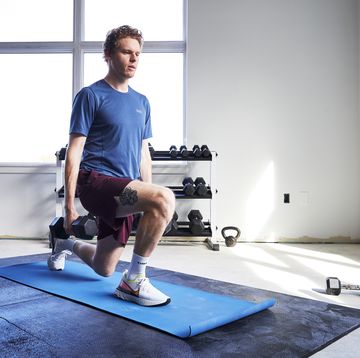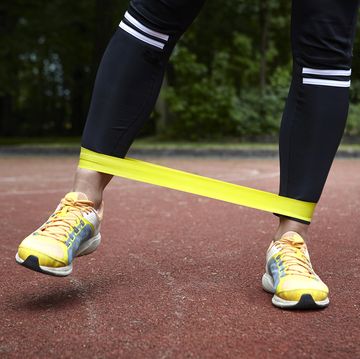If you borrow one element (besides running) from Rocky Balboa’s training regimen, make it stair-climbing. The plyometric motion strengthens the same muscles as lunges and squats, and taxes your lungs and heart as you power to the top.
“Stairs force you to work against gravity, and this helps build two essential needs for runners: strength and power,” says Anne Moore, M.S., an exercise physiologist and running coach in Charleston, South Carolina. You need both, whether you’re kicking to the finish of a 5K or trying to maintain pace during the later miles of a marathon.
Moore adds that stair-climbing “forces you to utilize muscle stabilizers, like the gluteus medius, that get neglected during regular runs,” because you’re balancing on and activating one leg, briefly, as the other moves to the next step. Strengthen these areas and you’ll reduce your risk of injury.
Finally, stairs are much steeper than most hills: Indoor stairs have a roughly 65 percent grade, while Boston’s Heartbreak Hill is just 4.5 percent. That’s why climbing them accelerates your heart rate so rapidly and makes you breathe faster to take in more oxygen. This, in turn, improves your VO2 max—the maximum amount of oxygen you can utilize during intense exercise.
“This teaches your body to use that oxygen and convert it to energy quicker,” says Moore. A greater VO2 max means you can run harder and for longer durations. A study in the British Journal of Sports Medicine found that short bouts of stair-climbing five days a week for eight weeks improved VO2 max by 17 percent among young women.
RELATED: Get stronger, faster, and stay on the road with the New IronStrength Workout for Runners
Weave these stair workouts into your weekly training and watch your performance reach new heights.
Run Up Like. . .A Competitor
A handful of races, including the Empire State Building Run-Up, involve ascending, as fast as you can, multiple flights of stairs (86—or 1,576 steps—for the Run-Up). Speeding up stairs takes a lot of explosive power, so you quickly reach your anaerobic threshold (AT), the point where your body creates more lactic acid than it can process.
“Training beyond your AT leads to an improved threshold level and ultimately a faster pace before you ‘feel the burn,’” says John Honerkamp, who oversees online training programs for the New York Road Runners. This is helpful even if you don’t aspire to stair-racing. (If you do, find events at towerrunning.com.)
The Workout: After a 10-minute warmup, run hard up stairs for 20 to 30 seconds, then walk back down. Repeat for 20 to 30 minutes. Or run stairs for 10 minutes after a long run to help your body build endurance and learn to push through fatigue.
Run Up Like. . .November Project
November Project, the popular fitness group based in Boston, meets for weekly stair workouts of all kinds in Harvard Stadium. One is “The Gilroy” (named for November Project member Scott Gilroy), which reverses the expected: You go slow up and fast down. “This builds mid-distance endurance because you put out a more consistent effort,” says Evan Dana, a coach who has been attending November Project since July 2012. “It also is a great calf burner, since you rely on your calf muscles to soften your steps as you come down.”
The Workout: Warm up for 10 minutes. Then climb 20 to 30 seconds up the stairs at a tempo effort—slowing as needed to keep your ascending pace consistent—and without pausing, run back down. Repeat the cycle for 30 minutes. If you’re in a stadium, run from section to section at the tops or bottoms of flights, maintaining tempo effort.
Run Up Like. . .A Gym Rat
If wintry weather forces you indoors and you can’t find a stairwell to run, you can use your gym’s StairMaster to perform an interval workout (20 to 30 seconds hard, then 30 to 60 seconds of recovery, repeating for 20 to 30 minutes) or a tempo workout (30 minutes at a comfortably hard effort).
Or use a treadmill. “Set at a steep incline, the treadmill is very similar to running stairs because you use many of the same muscle groups to propel yourself,” says Honerkamp. Obviously, adjust your speed accordingly—you may find that a fast walking pace is the most you can handle.
The Workout: After a 10-minute warmup, crank up the incline (slowing your pace as necessary) to 15 percent (or whatever the machine’s maximum incline is—the higher, the better). Do one minute at the hardest pace you can manage, then reduce the incline to zero and recover for one minute. Follow with two minutes at maximum incline and two minutes of recovery, working your way up, minute by minute, to five minutes of each. Then work your way back down to end with one minute hard and one minute recovery.













